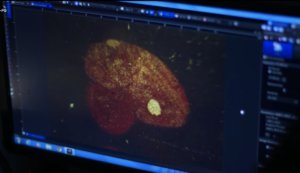
Summary:
The fourth episode, titled “First Words,” starts with clips of a family visiting a museum with their baby. The mother expresses her amazement that babies can learn a language while they do not know what language is. Dr. Kathy Hirsh-Pasek, director of the Infant Language Lab at Temple University in Philadelphia, tells a story of overhearing a three year old girl talking to her mother with very precise adult grammar. Babies hear “the melodies of speech” in their environment and somehow solve the problem of “mapping sound to language.” The British family explains how they have noticed tone is much more important than the actual sounds their son makes. Dr. Hirsh-Pasek describes her experiment which asks whether the melodies of language actually help us break language into smaller units. In their study, the researchers took samples of speech and put pauses in natural or non-natural places, then played the samples of speech out of different speakers and found that babies watched the side of the speakers with natural pauses for longer. Dr. Hirsh-Pasek also said that it is very likely that babies hear the patterns of language while they are still in the womb and they can distinguish between classes of language while very young. She also recommends the best way to develop strong language skills is to comment on what babies notice and pretend to have conversations.
In Madison, Wisconsin, Dr. Jenny Saffran, a psychology professor at UW Madison, explains how human culture is so dependent on language and knowing the meaning of words. Dr. Saffran describes that word learning is central to language acquisition and that babies may be learning language by statistics, determining which words go together frequently. Dr. Saffran made up a language with a few words that have no meaning and created a stream of the words in random order, so babies can determine which sounds, and words, go together. Words from the new language are played by themselves and are alternated with non-words, and babies control how long they listen to the sounds by looking in the direction of the speakers. The babies listen longer to the non-words as they get tired of the words that they have already learned. Dr. Saffran also tells the audience that babies who may not even be speaking can understand between 10 and 50 words by the time they are one.
A bilingual family in London has the father speak French to the children while the mother speaks English. Dr. Saffran details that babies in bilingual families can sort between the two languages by their “musical properties.” Dr. Erich Jarvis, a professor at the Lab of Neurogenetics of Language at Rockefeller University, is trying to understand why babies learn to speak later than they understand speech. Dr. Jarvis explains that among the vertebrates, there are only three birds and five mammals that are vocal learners, able to imitate a novel sound. Dr. Jarvis believes that the mechanism by which babies learn language is similar to that of how songbirds learn novels sounds. The brain regions used for speech and making sounds in both species are similar and further research revealed a connection between motor and vocal areas. The motor theory of vocal learning was developed, so muscles control our speech. Dr. Jarvis uses the analogy of spoken language as “learning how to coordinate your body.” Speech therefore comes with a delay because it is necessary to practice first. Humans have an extra copy of a gene called SRGAP2 which maintains more connections in the brain, and enables more sharing between cells and better learning. The episode ends with clips of three families reading stories to their babies before bed, while the experts speak about the gift of human language.

Review:
From the episode, it is clear that the best thing to do for an infant is to speak with it as much as possible and to try and enter into a “conversation.” This activity requires the caregivers to be close to the babies, also fostering a better relationship. In an article which describes the results of many studies about Infant-Directed Speech or Baby Talk, the authors write that “language learning is therefore powered by the shared social relationship between infants and caregivers” and “infants’ active participation in the conversation and maternal responsiveness to that participation” are “key elements in the acquisition process” (Golinkoff et. al 341). As Dr. Jarvis explained, infants learn speech through practice, and though they may sound unintelligible, they are building the foundations for future speech.
